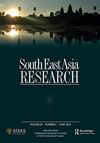东南亚国家对崛起中的中国的政策:越南对“一带一路”倡议倡议的对冲反应的教训
IF 0.9
3区 社会学
0 ASIAN STUDIES
引用次数: 0
摘要
“一带一路”倡议不仅标志着中国外交政策的重大变化,也为该地区国家,特别是长期受北京影响的东南亚国家带来了利益和挑战。本文认为,由于东南亚国家不同的经济发展水平以及每个国家对与中国关系的政治和战略考虑,东南亚国家采取了不同的政策来应对“一带一路”倡议。文章还指出,越南与中国接壤2000多年,经历了双边关系的起伏,越南通过支持该倡议但限制其参与来对冲一带一路。由于担心陷入中国的债务陷阱,以及由此对安全和主权产生的不利影响,越南拒绝了“一带一路”投资,并加强了与其他国家在基础设施投资方面的合作,以避免依赖中国资本。越南对“一带一路”的对冲政策也为地区国家提供了与其他强国建立多样化关系、避免依赖或反对新兴大国的经验教训。本文章由计算机程序翻译,如有差异,请以英文原文为准。
South East Asian countries’ policies toward a rising China: lessons from Vietnam’s hedging response to the Belt and Road Initiative
ABSTRACT The Belt and Road Initiative (BRI) not only marks a significant change in Chinese foreign policy but also brings benefits and challenges to countries in its region, especially those South East Asian states that have long existed under Beijing’s influence. This article argues that South East Asian countries have followed different policies in response to the BRI because of their different levels of economic development and each state’s political and strategic calculations regarding their relations with China. The article also points out that having bordered China for more than 2000 years, and having experienced ups and downs in their bi-lateral relations, Vietnam has hedged against the BRI by showing support to the initiative but limiting its participation in it. Vietnam has pushed back against BRI investments due to the fear of falling into China’s debt trap and the consequent adverse impacts on security and sovereignty, and it has enhanced cooperation with other states in infrastructure investments to avoid depending on Chinese capital. Vietnam’s hedging policy towards the BRI also offers lessons for regional countries about diversifying relations with other powerful states and avoiding dependence on or opposition to an emergent power.
求助全文
通过发布文献求助,成功后即可免费获取论文全文。
去求助
来源期刊

South East Asia Research
ASIAN STUDIES-
CiteScore
1.90
自引率
0.00%
发文量
42
期刊介绍:
Published three times per year by IP Publishing on behalf of SOAS (increasing to quarterly in 2010), South East Asia Research includes papers on all aspects of South East Asia within the disciplines of archaeology, art history, economics, geography, history, language and literature, law, music, political science, social anthropology and religious studies. Papers are based on original research or field work.
 求助内容:
求助内容: 应助结果提醒方式:
应助结果提醒方式:


